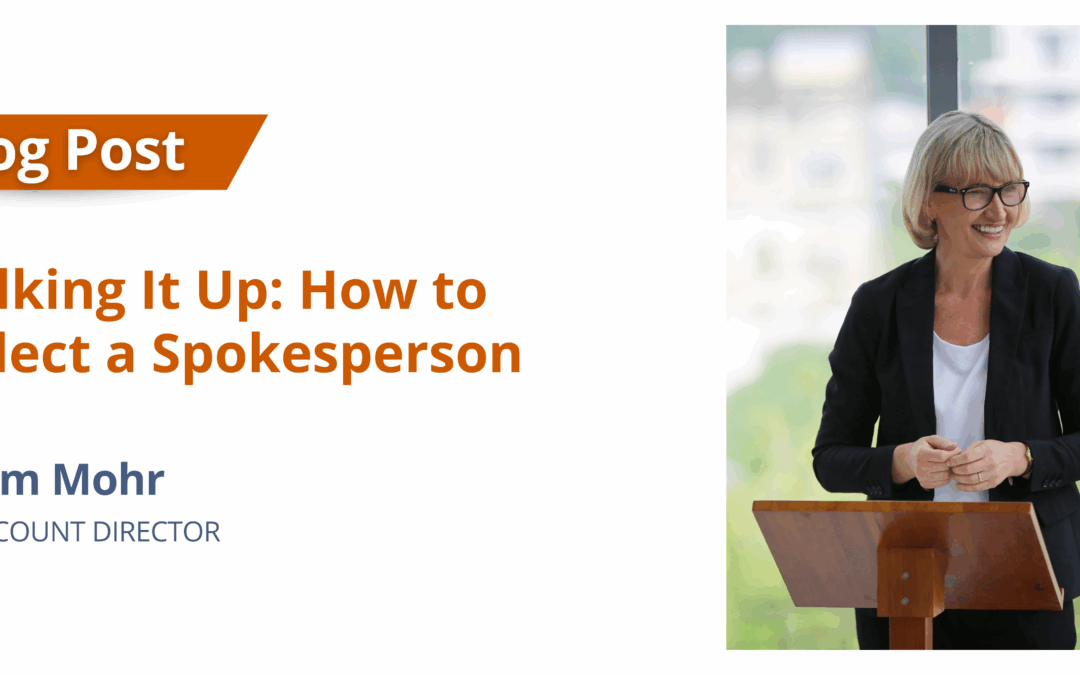
by Kim Mohr | Jun 10, 2025 | Blog
Many times, when we think of a brand that we know and love, we automatically associate that organization with the person who represents it in the public forum. Apple, the Dallas Mavericks, Nike and Microsoft have all had a notable spokesperson associated with their brand. While you may not have Michael Jordan on your bench, it’s as important for your organization to have a trusted frontman or woman to tell your story to the world.
So, Who Should You Choose?
While it may seem like a given to choose the head of your company, a recent article from pr.co cites research that shows the CEO is not always the way to go. Sure, the top boss might know the company and the technology better than anyone else, but does that person have what it takes to relay this knowledge in a relatable way that members of the media and the public can grasp and connect with?
When selecting a spokesperson, credibility is key. Even if your company exec is an expert on your product or service, it’s of the utmost importance that they have experience and knowledge that extends beyond the company talk track. Often, executives who have lived another life as a clinician, health system leader or hands-on data engineer make great spokespeople. They have worked through and grappled with the technology your solution is solving and can speak firsthand to the perils of the problem and the importance of a solution to like yours. Titles such as Chief Medical Officer and Chief Nursing Officer are often great choices. We’ve recently seen great interest in Chief AI Officers, and these executives are often adept to speak not only to the current state of technology, but they can offer insights into how we could see technology change in the near and long term.
Importantly, would you find the person you’re considering to speak for your company interesting to talk to over coffee or at a dinner party? Do they have a unique perspective? Are they passionate about finding a solve to the problem you are addressing? Media are people too, and just like you, they can get bored easily if a spokesperson comes across as static or rehearsed.
Another consideration: In key strategic situations, a company may select someone who is controversial to speak for the organization. Generally speaking, it’s best to avoid someone who runs the risk of alienating your customer base. If you’re considering a controversial or confrontational figure, work closely with your PR agency and internal stakeholders to weigh the pros and cons.
The more, the merrier?
A mistake some companies make lies in thinking they must choose just one person to speak for the company. This couldn’t be further from the truth. While you do want to maintain a consistent brand voice and drive home key talking points that have been determined through a thoughtful process, it is perfectly fine and often even preferable to have more than one spokesperson.
When using multiple spokespeople, differentiate based on each person’s area of expertise. Perhaps your CEO would be the one to give an interview to Axios a funding round, while your CMO would talk about the challenges of clinician burnout in a chat with a provider-focused podcast. Be deliberate when determining how many people will speak for your company. While a couple key leaders focused on disparate topics is great, too many voices can muddy the message and leave your audience confused. Additionally, determine who will speak for the company during a crisis (often your CEO or board chair) and develop a crisis communications plan that is shared with all relevant stakeholders in advance.
How to Build a Thought Leader
Once you have determined who will speak for the company, create a plan to introduce that person to the company. A PR plan should include thought leadership articles from your spokesperson that will be pitched and placed in key trade publications. To build credibility for your spokesperson and to secure earned placement, these pieces should cover a topic relevant to your space and avoid direct mention of your company. If your piece sounds like a sales pitch for your tech, it won’t see the light of day. Further, develop a social media content calendar that details posts for the company and your key spokespeople. Your audience wants to see that your leadership is part of the conversation in their area of expertise, so posting relevant articles from outside your company as well as engaging with outside content are all effective strategies.
A key part of being a spokesperson is, of course, speaking. Well before you schedule your first interview, schedule comprehensive media training for anyone who might be speaking on the company’s behalf. Amendola Director of Media Relations Grace Vinton offers tips for making the most of opportunities.
When it’s time to pitch, again, focus on broader areas of interest and prepare talking points in collaboration with your spokesperson and other stakeholders. You’ll often be given the chance to talk about what makes your company different, but let’s face it – no one likes someone who only talks about themselves all the time.
Additional Pitching Opportunities
While we often focus on health tech and healthcare trade publications and podcasts, Amendola Senior Writer Brandon Glenn reminds us in this recent blog post not to neglect mainstream media. Consumer and local outlets can provide golden opportunities in the right situations. Business publications such as the Wall Street Journal will often publish hiring news, so this can be a great option if your spokesperson has recently joined the company – a great way to get their name in front of a large audience. Axios loves big financial news, so if your spokesperson is willing to talk about a recent funding round or lucrative business deal, don’t overlook this mainstream outlet. Are you hosting a user meeting or participating in a charity even in the city where you’re headquartered or elsewhere? Try for an interview with the local business journal or morning news show.
Remember, too, that media is changing. While landing big publications is often the goal, smaller outlets can offer a precise target audience. Increasingly, bloggers and hosts of smaller podcasts are targeting the very audience you’re trying to reach.
Conclusion
Selecting a spokesperson is one of the biggest decisions you’ll make for your company. But don’t worry – remember these steps that we’ve covered here and you’ll be on your way to putting your company on the right path.

by Grace Vinton | Dec 11, 2024 | Blog
Anyone who has spent any time in healthcare can tell you that there is never any shortage of companies touting how their products are, “revolutionary” or “next gen.” We’ve all heard it: “This solution will transform healthcare into a Garden of Eden! Lower costs! Happier patients! Over-the-moon clinicians!”
Standing out in a crowded marketplace is always difficult, especially when you’re the one singing your own praises. That’s where strategic and thoughtful media interviews enter the picture.
Media interviews offer the opportunity to build credibility by leveraging a third-party’s brand, generate leads for sales teams, and deliver a story that resonates with target audiences.
However, industry thought leaders (yes, you!) most often approach media interviews as if they are merely question-and-answer exercises. Great media interviews are much more than that. They are relationship-building opportunities that enable executives to truly build relationships with journalists while educating the industry.
The most appealing stories in healthcare involve a mix of data and human impact. The detail and specificity required to tell these stories to reporters are unlikely to simply pop into executives’ minds on the fly. That’s why media interview preparation is essential.
The ABCs and the 3 Ps
While there are many subtleties and nuances involved in preparing for interviews, a good place to begin is what I call the ABCs and the 3 Ps. These are handy mnemonic devices to help executives get in the right mindset for interviews.
- Be Audible and always acknowledge the question
- Be Brief and bridge to your best arguments or proof-points
- Be Confident and clearly communicate your company’s key messages
To craft those key messages, begin by thinking about how to incorporate the 3 Ps:
- Proof points to help readers or listeners understand that the problem your company solves is actually a pressing problem for the industry, and data-driven examples of the effect your solution has in alleviating the problem(s)
- Stories about people and patients that illustrate the difference that your company’s products make in quality-of-life
- The deeper purpose that describes the “why?” of your company’s existence
While it’s wonderful to share inspiring and touching stories of how your product or technology led to “patients whose lives were transformed” or “doctors who overcame burnout to rediscover their love of practicing medicine,” it’s important to understand that, in reality, those stories aren’t always readily available, and massive change or sensationalism doesn’t always lead to the type of incremental progress required in the world of healthcare.
The most impactful stories can be how a new solution saves a few clicks in electronic health records or how it helps clinicians save time at the bedside. Those are still interesting stories that are worth telling; they just require a little strategic thought and planning to make them more accessible to reporters and understandable to the public.
To begin crafting a compelling story to share during media interviews, start with the ABCs and the 3 Ps – but above all, be generous with the wisdom you share. The industry will be better for it!

by admin | Jul 5, 2017 | Blog
Thought leadership is arguably one of the most powerful assets in an organization’s or individual’s public relations strategy. Yet relatively few companies go after the thought leader mantle, even if they have articulate, charismatic, true believers leading their organizations.
Often these potential thought leaders are kept preoccupied managing the present or near-future, while others who have an eye on the longer-term are hesitant to put their true thoughts out there, especially in the buttoned up world of business. And so, intriguing perspectives never see the light of day, including those that could establish a company or person as an industry player to watch.
By contrast, if you do a fair amount of thinking about the future, are amenable to investing time and effort into building your thought leadership profile and you’re willing to shake things up in your industry–then yes, you have the makings of a thought leader.
So where do you go from here? First, decide on what you want to be known for. Then decide on a correlating cause to champion. Let’s look at a well-known role model who has this approach down cold.
Thought leadership, Elon Musk-style
He’s extraordinarily rich, has a tempestuous romantic life and an unusual name. But above all, Elon Musk is an entrepreneurial futurist. That’s what people think first about Elon Musk, and that’s no accident.
I’ve long studied Musk’s thought leadership mode of operation and have distilled it to a simple pattern. First, he warns of a dire likelihood if humanity doesn’t get its act together. This generates significant buzz and fear. After a suitable amount of time has passed, Musk then follows up with a proposed solution.
Example: society will collapse when we run out of fossil fuels. Solution: Hyperloops that transport us at 700+ miles per hour.
Another example: society will collapse if artificial intelligence takes over the earth. Solution: merge human brains with artificial intelligence.
It’s all very calculated and strategic, and potential thought leaders should take note. Because it’s also undeniably effective. (By the way, Musk’s ideas have actual potential, fantastical as they seem. Take note of that, as well.)
How to find your thought leadership mojo
Here at Amendola I’ve developed a list of questions to provoke thought leadership thinking. I’ll share some of them here; for the full list, and more info about how Amendola builds and promotes thought leadership profiles; email me.
Question #1: If you could sound one alarm in your industry, what would it be?
Question #2: Do you have a minority and under-reported view of an industry topic that is significantly at odds with the widely held and established view?
Question #3: If you could rally your industry with one inspiring message or goal, what would it be?
These questions will likely prompt some interesting thinking, which leads to the next step what to do with these profound thoughts. In brief, you should put them into blog posts, articles, interviews, presentations and more, with a solid PR strategy to help promote your thought leadership message.
Thought leader-in-training
Another piece of advice: if you have the makings of a thought leader, start building your profile now. It’s not an overnight process, at all. In fact, it takes time to nail down your message in quote-friendly language, and to cultivate a media-favorite persona. My colleague Marcia Rhodes gives some good tips on the latter in her post “Be a Media Darling.”
Consider investing in media training, as well. In addition to our writing and PR services for thought leaders, Amendola offers in-depth media training, facilitated by experts with years of media experience in television, radio, newspapers and the internet.
It covers a lot, including:
- Body language and verbal best practices
- Tips for devising a memorable interview message
- Tips for assuring your quote gets published
- How to steer the interview back to your core messages when the interview meanders
And much more. The media training can be as short as one hour to longer, depending on your needs. We typically offer this training as a core component of our PR programs.
Don’t forget another time-tested public speaking strategy: joining Toastmasters.
In her post “Public Speaking Tips for the Timid and the Talented,” my colleague Michelle Noteboom details how participation in Toastmasters has upped her speaking game and given her newfound confidence.
Here is how Michelle recounts it: “Almost a year ago, one of my Amendola mentors encouraged me to join Toastmasters to further hone my speaking skills. While I was initially skeptical would everyone be a nerd? Or shy introverts with no personality? Perhaps retirees with nothing better to do? I have been pleasantly surprised by the mix of people in my club. It includes a variety of professionals in diverse careers, all of whom are fun and dedicated to self-improvement.”
She adds, “Toastmasters has given me the opportunity to deliver prepared speeches once or twice a month, as well as speak extemporaneously on random subjects. It’s provided an excellent forum for practicing speech organization and delivery, and for receiving feedback that pushes me to strive for continuous improvement.”
So there you have it a formula for success as a thought leader: an interest in the longer term, a willingness to shake things up in your industry, a solid PR plan, and a plan to practice until you’re close to perfect in your message delivery.
That’s really what it takes to be a thought leader. All that’s left is for you to take the leap and start becoming one.

by Matt Schlossberg | Dec 7, 2016 | Blog
The Day After
Wednesday, November 9, about 6am. Bleary eyed, I throw back a couple cups of black coffee and start collating and reviewing my notes, observations and potential talking points on the election results and their affect on healthcare PR before making phone calls and firing off e-mails to clients.
The GOP had captured the White House and retained majorities in both houses of Congress. From now until Inauguration Day political and policy reporters would be laser-focused on the agenda of the incoming administration, the Senate, and the House and the impact it could have on the country.
Healthcare specifically the future of the Affordable Care Act (ACA), Medicaid expansion and even accountable care is near the top of that list. Reporters and editors would be turning to the industry for their perspectives, hot takes and prognostications.
The Elephant in the Room
Many vendors and healthcare associations, especially those who work to some extent in areas of policy or advocacy, decline to publicly speak on political matters because they have to work with whichever party controls the executive and legislative branches. The increased intensity of partisan rancor also makes healthcare companies reluctant to comment on any hot-button topics for fear of losing customers or causing internal turbulence with key staff.
Industry leaders can certainly decline to speak and have legitimate reasons for doing so. But it’s critical that their public relations executives prepare them for that eventuality anyway.
There’s an old adage that says that politics and religion are the two forbidden topics at the dinner table. However, the former is not always an option for healthcare PR pros and their clients. Let’s face it: no matter your political affiliation, the results of the 2016 general election will likely have a significant impact on the healthcare industry,
Don’t believe me? Take 60 seconds to check out your news and social media feeds.
An Approach to Message
In the weeks leading up to Election Day, I had explored with my clients potential frameworks for how to respond to the priorities of a new administration and Congress. The differences between the two national parties on healthcare are both well-known and famously divergent. Democrats favor modifying and improving the ACA. Republicans campaigned on the law’s repeal and replacement.
I recognized a few potential hazards for my clients who chose to go on the record. First, much of today’s politics is personal and personality-driven. I felt that as a PR executive, my job was to frame the issue of healthcare policy in a way that was factual and focused on the policy and its potential ramifications.
The second major hazard is the perilous nature of predictions. Yes, non-partisan agencies such as the Congressional Budget Office had outlined potential impacts to healthcare based on candidates’ statements and plans. However, the political process is filled with too many twists and turns, too many procedural tricks and local political considerations to make any prediction a sure thing. In addition, speculation is often peppered with bias (any prime-time cable news panel is evidence enough of that).
Through my own research and discussions with clients, the overarching theme of nearly all perspectives was uncertainty. Campaigning is wholly different from governing. Nobody really knows what is going to happen. The healthcare plans of the two parties could not be more different. But how would political realities alter those stances?
For payers, providers and patients all of whom have invested incredible time, resources, and money into the implementation of the ACA uncertainty became a story unto itself. All of the information I had collected began to take shape as a narrative my clients could use as industry thought leaders while avoiding the volcanic clickbait statements that dominate today’s political discussions.
Lessons Learned
I wasn’t always in PR. I cut my teeth in journalism, and admit to viewing PR as a profession more focused on obfuscation than clarity. My 18 months working in PR has certainly changed my perspective and this first major election of my new career has offered me some critical lessons.
- Spin is Dumb. A general election is unique in so many different ways. A grueling 18-month campaign focused primarily on scandals and gaffes sometimes feels as if it is something to be endured rather than an opportunity to understand the principles and policies supported by the candidates. “Spin” is a major driver in the paper-thin evaluation of political candidates and their policies. I see my job as an opportunity to raise awareness and educate. But even honest assessments and insightful thought leadership requires calibration and planning.
- Messaging Matters. Even if your company is not interested in speaking to the press on any political matters, it’s smart to at least talk about it. We live in an omni-channel world. Everyone, it seems, has four or five social media accounts. Understanding how to approach your narrative will help you navigate the murkier swamps of policy and politics.
- Prep is Key. I’ve worked in healthcare for more than 12 years. Many of my clients have been in the biz even longer. And one of the reasons we are all successful is that we realize that we can always learn more. Collect as much information you can. A lot of it you’ll already know but seeking out a variety of perspective can help you shape how you tell your story.
There’s no getting around it. Reporters from national publications and healthcare trades are turning to the industry’s thought leaders for their perspectives on what the next four years could look like for the healthcare industry and the millions of people it serves. It’s critical that we present ourselves as knowledgeable and responsible sources of information.
Image Copyright pam fray and licensed for reuse under this Creative Commons Licence.




